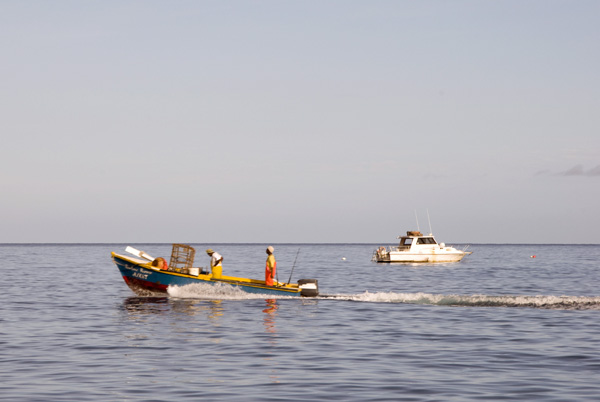 |
| The captain checks out a waterspout forming on the way to Montserrat |
We came into the empty anchorage, dropped the hook and dinghied in to clear customs. Clearing in was easy, though it was apparent they didn't clear in too many boats. The customs official couldn't find the forms she needed and the immigration officer was nowhere to be found. They told us it was no problem... we could just stop back later if we wanted to get our passports stamped.
 |
| The customs officer's desk in Montserrat |
 |
| Small fishing boats anchored at dusk in Little Bay |
 |
| Coming back from fishing; early morning Little Bay |
 |
| Saralane at anchor, Little Bay Monserrat |
Joe showed us cashews growing in the yard of a nearby church. The nut is visible at the bottom of the fruit. The fruit is hard to describe.... it's sweet and sharp and sucks all the moisture of our your mouth. Interesting, but definitely an acquired taste.
 |
| Baby avocados; they won't be ripe until summer. |
 |
| We stop by a neighbor's place and they offer us a coconut which Joe whacks open for us to drink. |
Montserrat is known as the Emerald Isle of the West because of it's original population of Irish immigrants, but it could just as easily be for it's green lush appearance. Irish Catholics wanting to escape religious persecution and prisoners shipped here from Ireland made up some of Montserrat's early population. Joe knew all the places to stop for views of these green mountains.
Here he took us to the rooftop of a friend's house to see out over the west side of the island. That little rock out in the distance is the country of Redonda. It's uninhabited, but still has it's own king. The royal position is chosen somewhat tongue in cheek... mostly it's whoever wants to be king. Why not? It's as good a way as any to choose a leader.
 |
| The building in progress is next door to a refurbished sugar mill that's now a guest house. |
We passed a little fall from a freshwater spring... rumor has it that if you drink from this spring, you'll return to Montserrat. Well.... we'd like to return. Skip drank too, but he had the camera, so it's only me in the photos!
From here we climbed higher into the mountains and closer to the volcano. We drove into the exclusion zone after checking in with the police who keep track of who's where in this no-go territory.
It's hard to describe the scale of the devastation. I'm not sure it even comes across in the photos. Even all these years since the volcano erupted, buildings that weren't completely destroyed or buried stand empty and decaying. Some are partially visible - half buried in the ash. A river disappeared beneath the flow of ash. Roads wind down the hills and disappear in the mud and ash.
We went through the Emerald Isle Hotel (top right, above).... and saw the portion of it still standing above the ash.
 |
| The hotel's pool filled with ash and mud. |
He took us to the famous Air Studios where so many rock stars recorded back in the day. Started by Sir George Martin, the likes of Paul McCartney, The Rolling Stones, Lou Reed, Dire Straits, Elton John, Sting, Eric Clapton and so many more recorded there. It stands in ruins now but Joe still thinks about the days when it brought Montserrat so much attention.
 |
| Flowers thrive in the rich soil |
It rained off and on all day as we toured the island. It may have felt different if we'd seen it on a bright sunny day with blue skies, but it was sad on this day in the rain and fog to see the remnants of lives lost and abandoned. Living and traveling on Saralane, we are aware of the power of nature out on the sea, but standing in front of the steaming Soufriere Hills volcano we had a very different sense of nature's power. We'd wanted to see Montserrat's volcano but we ended up feeling like disaster tourists - not a good feeling. The island felt disjointed and confused, the small population scattered. As upbeat as Joe was, he and others talked about feeling disconnected from each other.
As often happens when we have a short time to visit an island.... we feel the need to go back and see more. We'll still need the calm weather to sit in the exposed anchorages, but perhaps next time we should visit when the sun is out.
From Montserrat we mostly motored through windless calm seas back to St. Martin. Offshore we always drag a line or two in case a fish happens by. Two did! We only landed one. The other one got away buy likely ended up becoming a snack for someone else higher up than him on the food chain.
 |
| Little tuna. |














2 comments:
Well, this post was ....well....dark....kind of like an open wound. I remember how much Mom and Dad loved visiting there. But....the photo you took looking back at Saralane, all alone at the anchorage, really captured a sense of your own journey...from my perspective.
M & D due back today from St. C. Weather is pretty sucky. Cool, wet, grey. I wouldn't come back if I were you.
I'm sitting at home reading this post and it's making me homesick...
Post a Comment